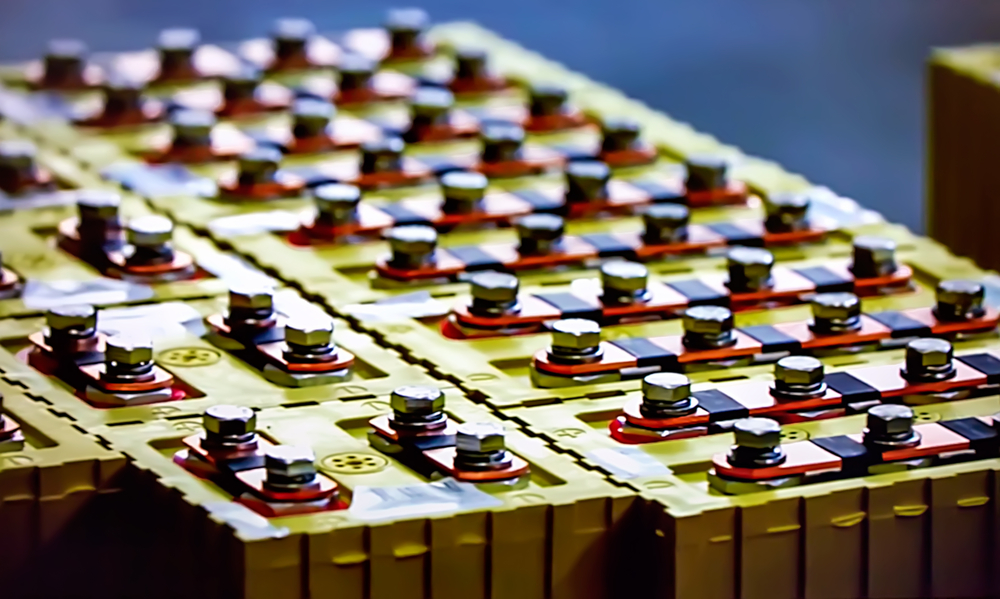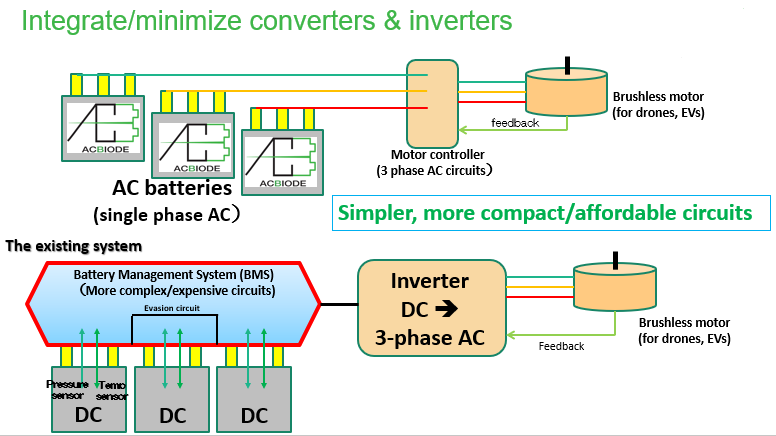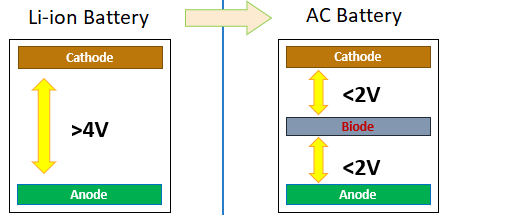Battery Tech Article
Standalone Alternating Current (AC) Batteries and Cockcroft-Walton Multiplier





Technology Overview
The technology owner had developed a patented standalone AC battery with a proprietary electrode design that has both the characteristics of anode and cathode. This enables the battery to generate AC power (square / pulsed wave form) from a single battery and a single switch. In a typical direct current (DC) to AC power conversion configuration used for brushless DC motors (BLDC) in drones and electric vehicles – multiple DC batteries, switches, complex battery management system and inverter circuit are needed to generate 3-phase AC to power a BLDC. The novel AC battery uses a simpler circuit design that minimises battery management system, converters and inverters.The use of the third electrode enables the voltage within the battery cells to be divided by half, e.g. while there is 4V between anode and cathode within the conventional Li-ion battery, the electrode can divide the voltage into 2V each, leading to safer operations and longer cycle life. The technology owner is looking at integrating the Cockcroft-Walton Multiplier (CWM), an established circuit that generates high DC voltage from an AC input as part of the AC battery system. The technology owner aims to boost the voltage, e.g. from 1.85V to 20V for industrial drones with an additional cost of USD200, while achieving 30% higher battery capacity with the AC battery and CWM combination.The technology owner had already developed several prototypes including a 100mA pouch cell. They are currently working on optimising the thickness of the electrode and preparing for a pilot test in industrial drones. The technology owner is seeking technical collaboration to scale up the AC battery prototype, develop integrated AC battery with CWM, conduct pilot test in drones, e-bikes, or e-wheelchair and eventually to license their technology to battery or battery parts manufacturers.
Technology Features & Specifications
Compared to the current DC batteries, the AC battery technology has the following advantages:1. Safer: The voltage within the battery cells is divided by the third electrode, leading to safer operations and thus improve yield rates at battery production lines - costing less to compensate the electrode cost. 2. Double the lifetime: The quality of the electrode particles is a limiting factor for DC batteries especially the cathode particles. However, it is not a limiting factor for AC batteries as AC, a shape of wave, can instead utilise the average, not the worst quality as average quality of electrodes increases and the battery can perform better in terms of duration and safety. In addition, the material of the proprietary electrode, Lithium Titanate is known to have improved lifetime. 3. Reduced cost of battery electronics: Electric circuit systems simpler, more compact and affordable - 30% more compact in terms of volume than the DC batteries that create AC, by avoiding the duplication of aluminumised films4. 30% higher capacity with Cockcroft-Walton Multiplier: Pending tests to confirm.5. Compatible with existing materials and battery production lines: Battery production utilises the existing materials and production lines of batteries and circuits with the same supply chain. The production cost of electrode is the same as that of an anode, manufactured by the existing roll-to-roll method.6. Chemistry agnostic: Applicable not only to Li-ion batteries but other types of battery including lead acid, all-solid-state batteries.7. Flexible: Applicable to the existing systems or infrastructure, where the input is AC and the output can be AC or DC, depending on the needs.
Potential Applications
In the short term: Small e-mobility, such as drones, e-bikes, e-scooters, e-wheelchairs.In the long run: Energy storage, EVs, regenerative brakes, boats and ships, flying cars, aerospace, etc.
Key information
Technology Category- Energy - Battery & SuperCapacitor
- Electronics - Power Management
ID Number: TO146026
Source: IPI Singapore
